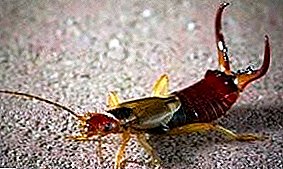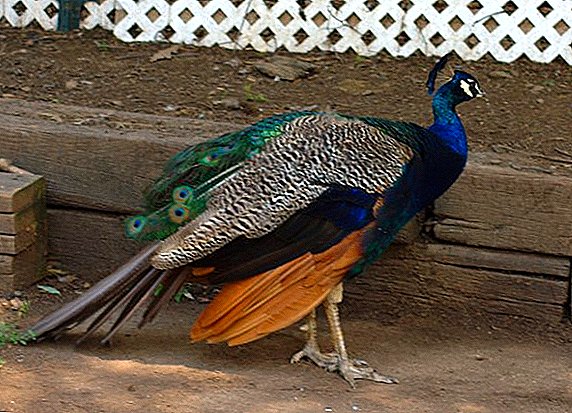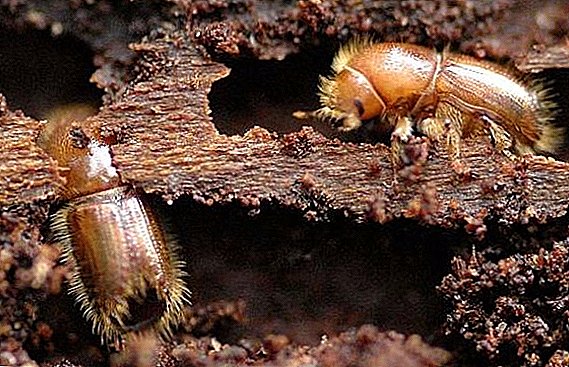
Not many people know that the earwig insect is the most common dvuvostok. Dvuvostok in large numbers can be found in gardens, gardens, and sometimes in residential areas.
About this insect goes a lot of frightening rumors. Dvuvostok is considered poisonous, capable of killing a person, namely: crawl into his ear, bite through the membrane and suck the brain.
But all this is nothing more than myths. What really is an earwig? What does it eat, how does it reproduce, and what harm does it cause?
Reproduction and species of insect
Earwig (Dermaptera lat.) refers to the order of the leather-winged insects with incomplete metamorphosis (the absence of the pupal stage in insects). This is a small insect about 2-3 x centimeters long, of a brown color. The name of its insect was due to its tail with two claws (toothed forceps) at the end.
The shape of the tail resembles the beautician's forceps, through which pierced the ears of women. It has a pair of short wings, but flies very rarely. On the head are eyes, mustaches and powerful jaws. Earworm is afraid of daylight, is nocturnal.
Photo earwigs:




Breeding
Fertilization dvuvostok usually occurs in late summer.
Fertilized females hibernate in the soil in previously prepared nests. Eggs usually occur in the spring, but sometimes in the fall, in which case the female winters in the nest together with laid eggs.
The male is also in the same nest with the female, but rarely survives until the onset of spring.
Having laid the eggs, (one clutch contains from 40 to 100 eggs), the female is constantly near the future offspring, protecting the eggs from the encroachments of uninvited guests for the entire period of their maturation until the appearance of larvae.
Larvae from adults differ in the size of the body and the absence of wings. A gradual transformation takes place as a molder, until the earwig turns into an adult insect.
 . Earwigs - not the only insects that can be found in our gardens and garden plots. Most of them are pests.
. Earwigs - not the only insects that can be found in our gardens and garden plots. Most of them are pests.Read useful materials about the Colorado potato beetle, cockchafer, bear, ants, spider mites, peppered moth, locusts, slugs, butterfly moth, aphids and thrips.
Earwigs representatives
Worldwide, there are about one and a half thousand species of this insect.
Here are some of them.:
- Earworm.
It reaches a length of 1.5-2 cm, has a dark brown color and strongly developed muscles. Cleverly uses ticks, is able to seize and hold prey, and also to defend himself like a spear.
Leads mostly nocturnal, hides during the day, gets food at night. The diet depends on the habitat: plant food, tree fungi, small insects.
- Coastal earwig.
It is distributed throughout the world and lives in a variety of climatic and natural zones. Soil type is important - sandy and super sandy soils along the banks of rivers, lakes and seas, as well as in forest belts.
Small earwig.
The smallest representative of this family. It is distributed everywhere, in length does not exceed 6.5 mm. Distinctive feature - leads daytime life.
- Asian earwig.
It has a bright color - black with yellow spots in the elytra zone. It has strongly curved mites and leads a daytime lifestyle.
As the name implies - lives in Asian regions. Can migrate, making flights. At low speeds, the height of movement can be up to 100 meters, the duration of such mass flights is two weeks.
- Central Asian earwig.
The species, completely lost its wings, lives high in the mountains, in the forests of the subalpine belt.
- Guinean cave earwig.
It differs from other species due to the specifics of its habitat. He lives in caves, where he is completely devoid of sunlight. As a result, there is practically no vision, the limbs and antennae are greatly elongated, the pigmentation of the outer integuments is very pale.
- Aryxenia.
Indo-Malay species earwigs. They live in caves, and some subspecies are able to parasitize on their neighbors - bats. Outwardly, they resemble the larvae more, the wings are completely absent, the claws are very weak, the vision is poor, and the body is covered with dense vegetation.
- Hemimera.
It lives in tropical Africa. This species belongs to parasites, as it lives mainly on the skin of a hamster rat. There is no vision, short limbs and no wings. A distinctive feature - the eggs develop into larvae directly in the body of the female. Some scientists propose to isolate these insects in a separate unit and not consider them earwigs.

Earworm

Coastal earwig

Small earwig

Asian earwig

Central Asian earwig
Nutrition
These insects are unpretentious and omnivorous. Favorite foods are fruits, vegetables, plants, especially garden flowers.
They do not disdain the remains of small insects. Often, in search of food, they can crawl into a dwelling house, where they feed on food debris from the table, destroy indoor plants, can crawl into a wardrobe and damage clothing.
Earwigs do not like daylight, crawling out in search of food at night. During the day they gather in a pile under the bark of trees, in the crevices of the boards, under stones, preferring dark and wet shelters.
In the houses they can be found in bathrooms, toilets, basements.
Is it dangerous for humans?
 Earwig: the danger to humans? All chilling stories about the cunning of a dvuvostok, which can destroy a person by penetrating his ear and damaging the brain is nothing more than fiction.
Earwig: the danger to humans? All chilling stories about the cunning of a dvuvostok, which can destroy a person by penetrating his ear and damaging the brain is nothing more than fiction.
Of course, she could crawl into some summer resident's ear if he suddenly wanted to take a nap right on the ground. What will happen if an earwig gets into my ear? The insect does not pose any danger to the ear and brain.
In this case, do not panic, and if possible, immediately contact a doctor and he will remove the unfortunate bug out.
The harm and benefits of earwigs
these small insects cause considerable damage to gardens, orchards, apiaries, eating plants, fruits, berries and flower petals (especially roses and dahlias suffer from them). Destroy stocks of bees in the hives. With a large cluster on the site can clean up the young seedlings cleaned.
In the arid period, dvuchostok cause serious damage to fruit trees, nibbling the tips of the leaves and undermining their roots.
But there are from dvostok and benefit. Eating fallen fruits and berries, the remains of small insects, earwigs act as orderlies of garden plots, clearing them from rot. By feeding on spider mites and aphids, they help plants that suffer from these parasites to survive.
 Not only earwigs and other insects can cause irreparable harm to your landings. On our site you can find useful information about other pests of the garden.
Not only earwigs and other insects can cause irreparable harm to your landings. On our site you can find useful information about other pests of the garden.Read all about wild rats, shrew, moles, bats and mice, gophers, wild hamsters. And also about ways to combat wireworm, locust, whitefly, sawfly and carrot fly.
Methods of struggle
In the garden or in the garden
- Pour boiling water over insects;
- spread out the traps in the form of wet rags, on which dvuhvostok will gather, then destroy the traps;
- dig a lot deep in the fall to help reduce unwanted guests next year;
- earwigs are afraid of the smell of vinegar, you need to spread on the site soaked with vinegar sponges for washing dishes.
In the House
- Thoroughly clean the room, plug all the cracks and eliminate all leaking pipes so that there are no damp places in the house so beloved by earwigs;
- lay out food baits (bran, tough egg yolk) mixed with an insecticide or common boric acid;
- during large-scale invasions of dvuvostok, it is necessary to call the sanitary-epidemiological service.
CAUTION! Lures spread out in places not accessible to children and animals.
That's all the necessary information about all the advantages and disadvantages of earwigs. The appearance of this insect is not quite acceptable, maybe because of earwigs and so many terrible rumors.
We bring to your attention a video about the invasion of earwigs:












